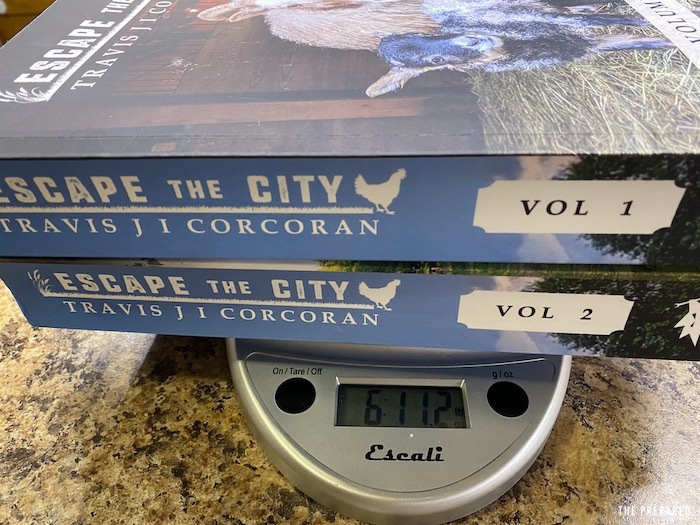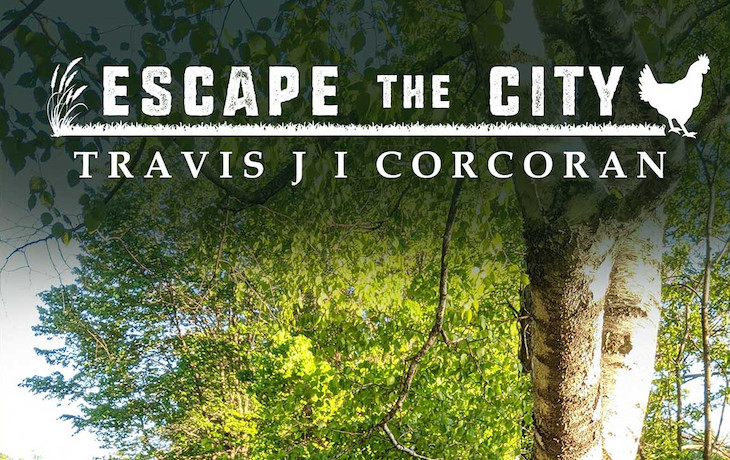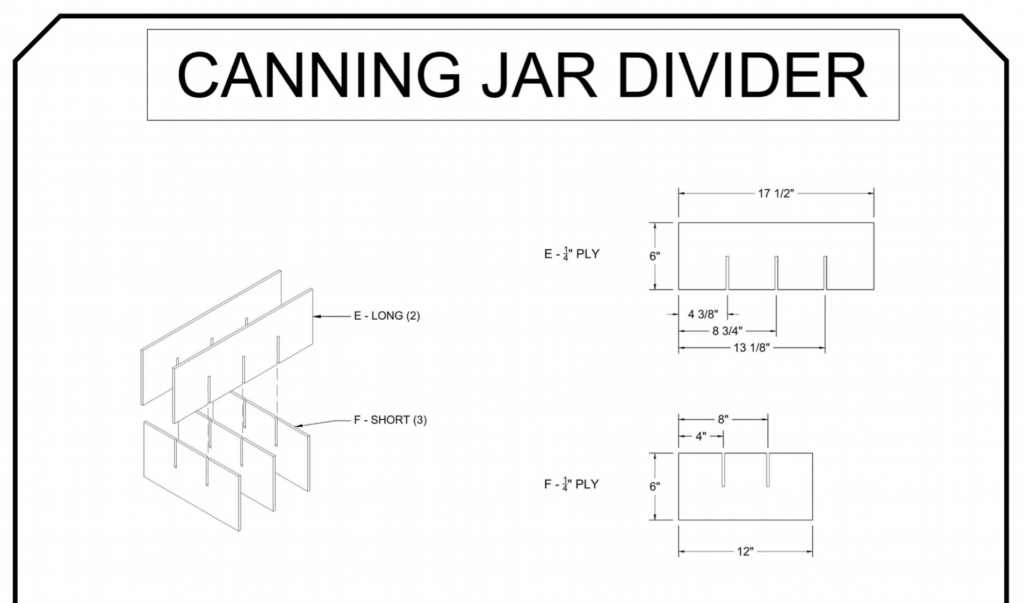A reader recently requested a review of Travis J.I. Corcoran’s gargantuan homesteading manual Escape the City, and I quipped that I would have to get through the first 5 or 6 pounds. That’s not much of an exaggeration: at over 1,200 8×10-inch pages, the two combined volumes weigh well over six pounds.
I’m mulling a review of Escape the City, but I have to get through the first 5-6 pounds or so. @theprepared
— Josh Centers (@jcenters) July 22, 2021
After getting in hot water over some spicy posts, Corcoran escaped Massachusetts nearly a decade ago for a 56-acre homestead in New Hampshire. When he’s not writing award-winning science-fiction novels and trying to tear down his neighbor’s illegal barn, he raises sheep and pigs, cuts firewood, brews beer, maintains orchards, builds various racks and shelves, grows crops, and all the various and sundry tasks you’d associate with a homestead.

When the COVID-19 pandemic caused many Americans to flee cities for the countryside, Corcoran decided to dump his years of homesteading wisdom into a book, which ended up becoming two books. Two very large books.
Truth is, I’ve been itching to review Escape the City (Volume One and Volume Two) since I backed it as a Kickstarter project. There was only one problem: how could I possibly review these overwhelming tomes of homesteading knowledge? The table of contents alone is over 35 pages long, and the introduction actually offers strategies for reading the pair.
Needless to say, these two volumes cover a lot. Everything from adjusting to country life, building infrastructure, raising and processing animals, buying and maintaining vehicles, woodworking, and blacksmithing.
And that’s only a small fraction of what the book covers.
More: Pandemic panic in the city? A country boy on what to expect from rural life
Summary:
- Corcoran’s style emphasizes efficiency, and to that end, he encourages heavy use of power tools, vehicles, and chemicals.
- Escape the City distinguishes itself from the rest of its genre with a focus on mechanical processes not often deeply explored in other books.
- Escape the City comes in three formats: paperback, hardcover, and Kindle. We recommend the paperback for being the easiest to thumb through.
- There is an extensive table of contents and index. Both have flaws, but largely replace the need for the search function in an electronic copy.
- Don’t think you can get away with just buying a single volume. The table of contents is in Volume One and the index is in Volume Two and the two refer back to each other often.
- The books feature numerous QR codes scattered throughout that you can scan with your phone to visit relevant websites.
- Escape the City may not be the only homesteading book you need, but it’s definitely one of the better starting points.
More: See Escape the City and other great titles in our recently updated guide to the best survival and prepper books
Where Escape the City fits in the genre of homestead encyclopedias
Escape the City is part of a long line of a genre I call homestead encyclopedias. These enormous volumes all aim to teach you everything you need to know about running a homestead. Notable entries include John Seymour’s The Self-Sufficient Life and How to Live It, Back to Basics (formerly published by Reader’s Digest and now by Skyhorse Publishing), and Carla Emery’s The Encyclopedia of Country Living.
The genre splits into two broad categories: encyclopedias from the perspective of a single person, and anthologies from a mishmash of authors. I tend to prefer the single-author guides because they’re more consistent and flavorful than the anthologies, and they tend to be written by homesteaders with skin in the game and their reputation on the line, not random freelancers. (Though Back to Basics is one of the better anthologies.)
All of them are flawed in different ways by their very nature. No single book, no matter how thick, can possibly teach you everything you need to know about running a successful homestead, and all have their own biases.
Corcoran leans toward the industrial and efficient. Diesel, gasoline, and glyphosate are all key chemicals on his homestead. An essay near the end of Volume Two is called “Roundup is Next to Godliness.” That’s a very different take than most homesteading books, which encourage organic methods.
Corcoran has a lot of hard-won wisdom from his years running his homestead and has little patience for armchair experts and LARPers. Of food forests, he says:
The reason I hate the concept is that it’s part, or at the very least adjacent to, an armchair-expert something-for-nothing free-lunch wishcasting worldview, where people who haven’t actually done a thing or researched it deeply pontificate on how they’d do it better, and construct theoretical castles-in- the air, connecting a bunch of true facts into a pattern that ignores friction and hassles.
Corcoran also isn’t a fan of John Seymour, and goes on at length ripping apart his essay, “Start a 1-Acre, Self-Sufficient Homestead“:
This article is recirculated not because it is correct or useful, but because it’s the kind of article that people want to read. Everyone wants to lose twenty pounds while eating ice cream. Everyone wants to get ripped despite not lifting heavy-ass weights. Everyone wants to be irresistible to the opposite sex while not engaging in any self-improvement… And everyone wants to be self- sufficient without having to buy a lot of land.
You won’t find hippy-dippy idealism here. Cocoran doesn’t hesitate to dish out harsh truths, like why home distilling is a bad idea because the ATF can make your life a living hell even if you do everything by the book, or why prepping for TEOTWAWKI is a terrible idea if you don’t even have an emergency fund.
The layout of the book
They say you can’t judge a book by its cover. This is patently untrue, as you can often learn a lot about a book by its cover. And when it comes to large reference works like Escape the City, things like formatting and references matter. (That’s why many bibles have features like thumb indexes, ribbons, maps, lexicons, and other things to make them digestible.)
There are three editions of the book available: paperback ($24.99 for the first volume, $22.49 for the second), hardcover ($49.95 per volume), and Kindle (about $20 for the pair). As a Kickstarter backer, I bought the paperbacks and I also received some electronic copies in formats you otherwise can’t otherwise obtain, like OpenOffice, plaintext, and PDF.
Of the three formats available now, I would opt for the paperbacks, which are like large metropolitan phonebooks (if you remember those). I’d be afraid the hardcovers would be way too heavy and awkward, plus I couldn’t flip through them as easily as I can the paperbacks.
With big reference books like this, I often like to have both hard and electronic copies, but I’ve had trouble with my electronic copies due to their sheer size. The PDF is 76 MB and while it’s helpful for search, my Mac often chokes on it. My iPad also struggles with the plaintext copies I’ve downloaded. I haven’t even dared to force these behemoths on my poor Kindle. (Nearly 200 MB for both volumes.)
The good news is that the paper books are so well structured that you don’t need a search function. It’s organized like a wiki, so you’ll have a section called Meat Processing, followed by Meat Processing: Equipment, Meat Processing: Equipment: Slaughter, Meat Processing: Equipment: Slaughter: Poultry, Meat Processing: Equipment: Slaughter: Poultry: Hatchet and Log, and so on. These sections and subsections are all itemized in the table of contents, which is why it’s so long.
Unfortunately, the table of contents isn’t perfect and is often off by a page or two. For instance, it lists instructions for changing engine oil on page 352 when in fact it’s on the previous page, 351. It’s not much of an annoyance, but it is an annoyance.
There is also a 56-page index at the back of the book. However, it’s apparently computer-generated, so you get odd entries like “base” or “case” with a big chunk of page numbers. However, many of the entries are more specific with fewer page numbers. The index serves almost like a dead-tree version of an ebook’s search function. I’d like to see a human-curated index in a future edition, but with the excellent organization of the book and the detailed table of contents, this is really a minor complaint.
You may wonder if you can get away with just buying a single volume. You can, but you’re going to be frustrated, as the two are intended as a single work. The table of contents is in Volume One and the index is in Volume Two.
Many homesteading books, like The Self-Sufficient Life and How to Live It and Back to Basics offer lots of pretty color illustrations. You won’t find that in Escape the City and the paperback is all black-and-white. This isn’t always a bad thing: there are some pretty gruesome animal slaughter images that you may not want to see in color. Despite that, there is a small photo for pretty much every main section.
And Escape the City has something many how-to books lack: detailed diagrams when you need them. There are so many woodworking books with only textual descriptions to go off, maybe paired with vague diagrams. Not here. When Corcoran explains how to build a shelf or a storage crate, he also provides blueprints with multiple views so you can be sure of what you’re doing.
Corcoran embeds another innovation into Escape the City: QR codes with web links to products and articles he refers to. Most smartphones now let you point the camera at these little squares to open URLs. This feature may not age well over time, as links break or if the Internet collapses, but he routes all of the links through his own website so he can easily maintain them.
The actual content
This being a single-author encyclopedia, some sections are stronger than others. Some topics are missing entirely (like raising meat rabbits), while others are there, but say something along the lines of “I don’t have much experience with that.” That’s honest but somewhat frustrating.
However, if you’re looking to make your move to the country, Escape the City delivers on all fronts. Corcoran dedicates about 40 pages near the front to considerations, including adapting to country life and deciding whether you actually want to leave the city, dealing with neighbors, buying the right amount of land, and how to haggle for land and equipment. He offers 10-year, three-year, and one-year plans for making your move and setting realistic goals.
Corcoran is a real nuts-and-bolts guy, and Escape the City shines when he’s talking about tractors, chainsaw selection and maintenance, and building a workshop. It may be the only book you ever need on tractors or welders, outside of their respective owner’s manuals. He offers a lot of specific recommendations on products to organize your shop, and I’ve recommended the book to friends and family who are otherwise uninterested in homesteading just for the workshop section.
Escape the City covers many of the mechanical things on a homestead that other books skip or skim over. There are over 20 pages dedicated to vehicle maintenance, including how to manage batteries, fix tires and rims, and change engine oil. Corcoran provides detailed instruction lists, but not much in the way of visuals. However, if you’re absolutely clueless about these things, this will be a tremendous starting point for you.
Corcoran also delves into the economics of many of the activities outlined in the book, like raising animals for meat and making hay. Given rapid inflation and general economic wonkiness, you’re going to have to adjust these figures, but they’ll give you a starting point to think about.
About 50 pages of the book cover animal slaughter and butchering in exhaustive detail. This is yet another place where the book shines, with not only detailed instructions but warnings about potential gotchas and what to do when things go wrong. I can’t review all of it from experience, but his instructions on dispatching chickens with a hatchet are as detailed as I’ve ever read.
But while some sections are extensively detailed, related topics can be lacking. Corcoran writes at length on harvesting and processing firewood and dealing with chimneys, but only offers a bit over a paragraph on wood stoves (he has much more to say on wood boilers). He offers very brief overviews of rainwater collection and greywater harvesting, but not enough to accomplish much (though he does reference an excellent-sounding book on greywater recycling).
Corcoran dedicates several pages to gardening, but it’s more of a rough outline than a complete guide, and when it comes to specifics on many plants, he admits that his wife handles much of the gardening. He doesn’t have much to say on insectoid garden pests other than the Colorado Potato Beetle. However, there are some gems buried within, like architectural retaining wall blocks as a raised bed material, and tracking your garden with a spreadsheet (though it would be nice to have a template instead of a description of the sheet).
In short: Escape the City is strong on the sort of crunchy/mechanical processes many homesteading books are weak on, and less strong on the squishy sorts of things that most homesteading books emphasize.
But that’s not to say the book is all ruthless efficiency. Corcoran touches on blacksmithing, scything, timber framing, and other skills of yesteryear that may become more relevant in the future. He also tells you how to spend months planning for a Viking party (how he finds time for all of this, I have no idea).
It’ll be interesting to see how the book evolves in future editions, assuming there are future editions. Carla Emery spent decades refining and expanding her encyclopedia, leaving bread crumbs along the way of a life of hardship and tragedy. Corcoran cranked out Escape the City in about a year after less than a decade of experience, and already has a work comparable to Emery’s.
Is Escape the City for you?
Escape the City absolutely belongs in your library if you have an interest in homesteading or DIY in general. That’s especially true if you’re looking at homesteading later in life — Corcoran was 42 when he moved to his 56 acres.
There are really only two remaining questions: is it the only book you need? Perhaps, if you live in a similar environment as Corcoran and do everything his way. Otherwise, you’re going to want to supplement it, though he has many good book recommendations scattered throughout.
The second question is: is it the first homesteading book you should buy? If you lean more toward the organic/granola way of doing things or have a smaller plot of land, you might be better off first buying Carla Emery’s The Encyclopedia of Country Living as a starting point (a book Corcoran recommends as a complement to his own) or even Ben Falk’s The Resilient Farm and Homestead (our review), which is a good entry point for the permaculture side of things but isn’t quite a comprehensive encyclopedia.
My central critique of Escape the City, from a preparedness perspective, is that while yes, chainsaws, tractors, and chemical fertilizers can save you a lot of time and hassle, and welders and table saws are wonderful and powerful tools, what happens if cheap energy vanishes and supply chains are shattered? We’ve seen hints of both in the past year, with COVID-19 regularly disrupting supply lines and President Biden pleading with OPEC for more oil production and being denied.
Corcoran undoubtedly gets a lot more done on his homestead than I do on mine, but I’m constantly thinking about what I would do if I couldn’t get gas, didn’t have power, and couldn’t go to the stores or even order what I need from Amazon. That leads me to some exhausting and inefficient practices, like breaking hard ground with a broadfork and cutting grass with a scythe, but in return, I get a sense that if things really did hit the fan, I might be able to get along anyway.
However, it’s easy to start homesteading with the intention of chopping trees with axes, forging your own tools, scything hay, and building crates with carefully cut joinery. Then the overwhelming reality of responsibilities sets in, you find yourself hopelessly behind on everything, and next thing you know you’re at Tractor Supply buying a cordless drill and a chainsaw. When that happens, you’ll be happy to have Escape the City on your shelf.



You are reporting the comment """ by on